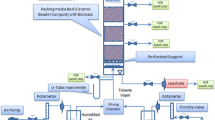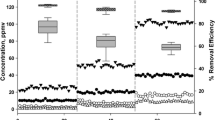Abstract
The removal of toluene from waste gas was studied in a trickling biofilter. A high level of water recirculation (4.7 m h−1) was maintained in order to keep the liquid phase concentration constant and to achieve a high degree of wetting. For loads in the range from 6 to 150 g m−3 h−1 the maximum volumetric removal rate (elimination capacity) was 35±10 g m−3 h−1, corresponding to a zero order removal rate of 0.11±0.03 g m−2 h−1 per unit of nominal surface area. The surface removal was zero order above the liquid phase concentrations of approximately 1.0 g m−3, corresponding to inlet gas concentrations above 0.7–0.8 g m−3. Below this concentration the surface removal was roughly of first order. The magnitude of the first order surface removal rate constant, k1A , was estimated to be 0.08–0.27 m h−1 (k1A a=24–86 h−1). Near-equilibrium conditions existed in the gas effluent, so mass transfer from gas to liquid was obviously relatively fast compared to the biological degradation. An analytical model based on a constant liquid phase concentration through the trickling filter column predicts the effluent gas concentration and the liquid phase concentration for a first and a zero order surface removal. The experimental results were in reasonable agreement with a very simple model valid for conditions with an overall removal governed by the biological degradation and independent of the gas/liquid mass transfer. The overall liquid mass transfer coefficient, KLa, was found to be a factor 6 higher in the system with biofilm compared to the system without. The difference may be explained by: 1. Difference in the wetting of the packing material, 2. Mass transfer occurring directly from the gas phase to the biofilm, and 3. Enlarged contact area between the gas phase and the biofilm due to a rough biofilm surface.
Similar content being viewed by others
References
Arcangeli JP & Arvin A (1992) Toluene biodegradation and biofilm growth in an aerobic fixed-film reactor. Appl. Microbiol. Biotechnol. 37: 510–517
Ashworth RA, Howe GB, Mullins ME & Rogers TN (1988) Airwater partitioning coefficients of organics in dilute aqueous solutions. Journal of Hazardous Materials 18: 25–36
Characklis WG & Marshall KC (1990) Biofilms. Wiley Interscience, New York
Barker TB (1985) Quality by experimental design. Marcel Dekker Inc.
Diks RMM & Ottengraf SPP (1991) Verification studies of a simplified model for the removal of dichloromethane from waste gases using a biological trickling filter. Bioprocess Engineering 6: Part I 93–99, Part II 131–140
Jensen HM (1994) Cometabolic degradation of chlorinated aliphatic hydrocarbons. Ph.D. thesis (in preparation). Department of Environmental Engineering, The Technical University of Denmark
Kirchner K, Schlachter U & Rehm HJ (1989) Biological purification of exhaust air using fixed bacterial monocultures. Appl. Microbiol. Biotechnol. 31: 629–632
Mackay D & Shiu WY (1981) A critical review of Henry's Law constants for chemicals of environmental interest. J. Phys. Chem. Ref. Data 10: 1175–1199
Ockeloen HF, Overcamp TJ & Grady Jr CPL (1992) A biological fixed-film simulation model for the removal of volatile organic air pollutants. 85th Annual Meeting & Exhibition, Air & Waste Management Association. Kansas City
Ottengraf SPP & Oever v.d. AHC (1983) Kinetics of organic removal from waste gases with a biological filter. Biotechnol. Bioeng. 25: 3089–3101
SAS (1985) Version 6, release 6.02. SAS Institute, Inc., Cary, N.C.
Schindler I, Friedl A & Schmidt A (1994) Abbaubarkeit von Ethylacetat, Toluol und Heptan in Tropfkörperbioreaktoren. In: VDI Berichte 1104 (pp 135–147). VDI Verlag
Severin BF, Shi J & Hayes T (1993) Destruction of gas industry VOCs in a biofilter. IGT Sixth International Symposium on Gas, Oil, and Environmental Technology. Colorado Springs
Wolff F (1992) Biologische Abluftreinigung mit einem intermittierend befeuchteten Tropfkörper. In: Dragt AJ & van Ham J (Eds) Biotechniques for Air Pollution Abatement and Odour Control Policies (pp 49–62). Elsevier Science Publishers B.V.
Author information
Authors and Affiliations
Rights and permissions
About this article
Cite this article
Pedersen, A.R., Arvin, E. Removal of toluene in waste gases using a biological trickling filter. Biodegradation 6, 109–118 (1995). https://doi.org/10.1007/BF00695341
Received:
Accepted:
Issue Date:
DOI: https://doi.org/10.1007/BF00695341




